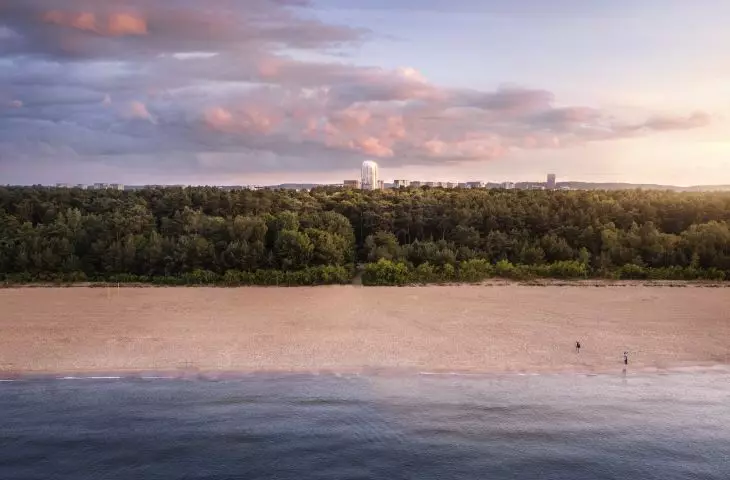There is nothing wrong with buildings sticking out above the surrounding development. On the other hand, the problem arises when this happens haphazardly, without coordinated landscape and composition studies," says Monika Arczynska, architect and co-founder of A2P2 architecture & planning.
Ewa Karendys: Does the 99-meter Big Boy fit in an important waterfront location?
Monika Arczynska*: - The first question that comes to my mind is whether we should interfere so much with the silhouette of the city at all? Such a decision has both supporters and opponents. In the visualization of Big Boy from the sea, you can see that the building will strongly protrude above the line of greenery and buildings in the waterfront strip. I myself side with the proponents of limited height and an unobstructed silhouette in this area. It seems to me that it is unique that in a large, attractively touristic city, it has so far been possible to preserve the coastal strip and its surroundings without tall buildings. In my opinion, this is a value that we should protect.
Ewa Karendys: The landscape viewed from the sea is not completely devoid of skyscrapers today, we can see Olivia Star and the Sea Towers.
Monika Arczynska: Yes, with Olivia Star being withdrawn, it is located in the Central Service Belt. The Sea Tow ers, on the other hand, are indeed highly exposed. However, they mark a very important point of the Gdansk Bay waterfront - Gdynia's downtown - and therefore their presence may seem justified. In the case of Big Boy , it is simply one of the landmarks of Przymorze, a residential neighborhood, and a dangerous precedent that could lead to the construction of more buildings of similar scale in the waterfront strip area.
Big Boy to be built in Gdansk's Przymorze district
Ewa Karendys: In the case of Big Boy, the biggest controversy is not so much the height, but the appearance of the building, which many find disappointing.
Monika Arczynska: Yes, I am disappointed too, especially since developer Hossa has many successful projectsin its portfolio, including Garnizon, which I show to both students and visiting architects in Gdansk. It seems to me that if Big Boywere to actually be built, it should be of a higher architectural quality. Prof. Piotr Lorens, Architect of the City of Gdansk, said that "this place deserves more sophisticated architecture." I don't know if "sophisticated" is an accurate term in this case, but the concept presented definitely lacks subtlety and coherence. The wave motif is very literal, and the design proposal is a conglomerate of rather random architectural elements. It does not form a coherent whole and will look very heavy.
On the other hand, the very combination of the residential function and the hotel function is quite interesting, because it is a rare combination. I suppose the hotel was put there because of the lower parking rates for this function. Because if there was going to be residential development in its entirety, there would have to be more parking.
Ewa Karendys: Do you remember earlier projects, such as the one that took the form of a sail?
Monika Arczynska: I remember, but it was a project in the climate of the 1990s or early 2000s, and I'm glad it didn't get built. Besides, the very provisions of the local plan for the area, with no height restrictions on development, are a vestige of those times, when one was supposed to primarily build a lot. Today we think about quality, and in the case of skyscrapers the emphasis is on making them "sit" well in the silhouette of the city, as a sign seen from a distance. On the other hand, urbanistically, skyscrapers are catching up with development, but such activities should take place in locations best connected by public transportation.
Ewa Karendys: The environment in which Big Boy is being built is chaotic. There is a wave building there, low blocks of flats built in the People's Republic of Poland, and in recent years there has been intensive development that can hardly be considered an example of good architecture. Just look at the project near the entrance to Reagan Park, for example.
Monika Arczynska: I have the impression that these developments were designed to maximally fill the allowed volume, without much thought to the visual or functional side of the projects. This is a pity, because these are expensive projects and with a high budget it is easier to have high quality. There are also tools to assess the visibility of planned facilities. Such studies have been conducted, for example, for the area of the Imperial Shipyard (made by the team of the Center for Cyber Urbanism at the Faculty of Construction and Architecture of the West Pomeranian University of Technology in Szczecin) or for the Praga Port in Warsaw, where we developed master plans.
In Gdansk, there is a Height Location Study (so-called SLOW), which suggests limiting heights in the residential areas of the Lower Terrace to 55m - the limit between tall and high-rise buildings. In turn, in the coastal strip, it is advisable to push back tall buildings, excluding the Haller Street area.
When designing a high-rise building - and one that is still so highly exposed - there should be a discussion about what kind of development would be most appropriate in a given location. A formula that would probably work well here is a competition, because thanks to it you can compare different variants and choose the optimal one.
Ewa Karendys: In Gdynia, city planners for the most important, downtown, locations have written the requirement for a competition into local plans. This is happening with varying results, but the choice is transparent, and projects can indeed be compared.
Monika Arczynska: Yes, there were admittedly some doubts about the compliance of such a requirement with the regulations, but investors who care about good relations and acceptance of the project by the city comply. For one of the investors we organized a competition for a new development in the area of the South Pier. Importantly, unlike local governments, private investors are in no way bound by public procurement law, so they can go directly to the best design offices. This is a sure guarantee of quality.
Ewa Karendys: Visualizations of the Big Boy investment are presented to the public a year after the construction permit is granted. That is, when the doorknob for the implementation has long since fallen. In addition, the project for such an important location did not make it to the evaluation of the City Architect. Doesn't this surprise you?
Monika Arczynska: Unfortunately, in the current procedure in Poland for obtaining a building permit, there is no such thing as consulting the project, and the City Architect can do little.
Ewa Karendys: But he can take advantage of "soft" measures, i.e. enter into talks with the investor - which has already been successful in Gdansk.
Monika Arczynska: That is correct. On the other hand, it is easier to undertake such discussions in the context of areas under conservation protection, because the project would require arrangements with a conservation officer.
Ewa Karendys: You said that you are not in favor of high development. On the other hand, the local plan does not limit the height for this plot. Is it possible to imagine a very tall building in this place, but one that will fit in well with the surroundings?
Monika Arczynska: There is nothing wrong with buildings sticking out above the surrounding development. On the other hand, the problem arises when this happens haphazardly, without coordinated landscape and composition studies. A good example of a tall building that blends in perfectly with its surroundings is the Alto Vetro Tower in Dublin's Docks district. Although it is much lower than the planned Big Boy, the surrounding buildings are much lower than it, and this slender "skyscraper" was perfectly integrated as a spatial keystone at an important point at the end of several view axes. It emphasizes the shape of the harbor basins, and without it this place would not be so attractive. This Dublin building looks good from any point, because it is thoughtfully located and has great proportions. If a tall building is well designed and located, it can be a great added value to the space in which it is built.
*Monika Arczynska - co-founder of A2P2 architecture & planning, a consulting and design firm involved in, among other things, master plans (Stare Świdry in Warsaw, Imperial Shipyard in Gdansk with HLA and BBGK, Port Praski inWarsaw), public spaces (woonerf in Abrahama Street in Gdynia with NANU, Wolności Square in Lodz with mamArchitekci), pre-design consultancy and participatory activities across the country. Assistant professor at the Faculty of Architecture at Gdansk University of Technology, member of the Gdansk MKUA and the Gdansk Architecture Council.






























